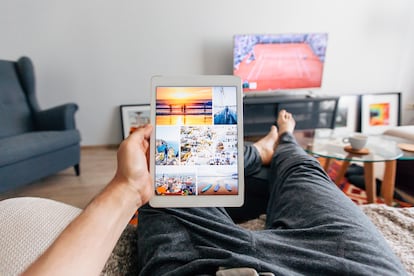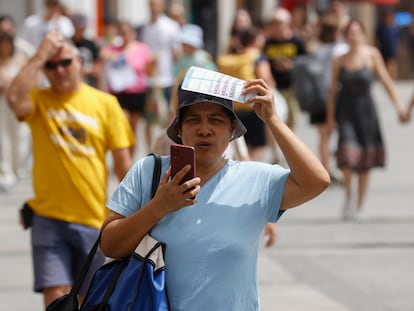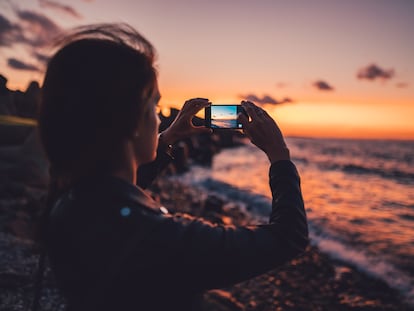Too many photos this summer? Tips and apps to keep them in order and locate them after your vacation
Artificial intelligence comes in addition to classic solutions, like tagging images, searching for duplicates and sorting them into albums

Cell phones have become predominant when it comes to photography and have long since replaced conventional cameras. It is estimated that by 2023 each user will take an average of 2,100 photos from their cell phone. Of the total number of photos expected to be taken this year, an estimated 92.5% will be shot from a cell phone.
As there is such a large volume of images, it is essential to maintain a well-organized photo library on your phone. In this regard, Rodrigo Rivas, an expert in mobile photography, suggests ensuring a certain level of upkeep of your photo library. He is speaking about duplicates, screenshots and blurry photos that are left there because of carelessness and ultimately blight the user experience. “I use Gemini, an app that allows you to detect duplicate photos,” explains Rivas. This enables you to locate and salvage your treasured memories efficiently, and also to optimize storage space, as duplicate photos can consume valuable space on your device.
iPhone expert Fran Besora underlines the importance of being able to locate the photos you are looking for amongst the mass of images that can build up after a vacation. Besora stresses the importance of tagging your snapshots: “I tag the photos so that I can easily locate them in the search engine, I create albums to sort the photos and I mainly use the Favorites function.” This specialist recommends ongoing review and proactive tagging, in order to ease the process of locating specific images in the future.
Fortunately, manufacturers are fully aware of the clutter that is gradually accumulating on their devices, as taking photos is easy, fast and, most importantly, free of charge. For this reason, they have equipped them with systems using artificial intelligence, which enable us to locate the elements in different photos. This means that you can type the word ‘dog’ into your cell phone and snapshots with dogs in them will pop up. This function is already built into most cell phones, but nevertheless, Rivas recommends using services in the cloud: “To organize photos with artificial intelligence, I think the best app is Google Photos or the default photo app on iOS and Android.”
Additionally, he suggests the use of geolocation to locate the desired photos: “It is good to always have the location (GPS) enabled, because this will allow us to group them in many apps according to time, day or place.”
How to organize your cell phone’s photo library
Initial cleaning. Don’t be afraid to delete. At worst, deleted photos will remain in your device’s trash garbage can for a while before disappearing for good. So, if you are not sure that a photo is suitable, if in doubt, it is always advisable to delete it. When it comes to duplicates, blurry photos and screenshots, use applications such as the previously mentioned Gemini, or Duplicate Photos Fixer or Remo Duplicate Photos Remover to make it easier to identify and automatically erase duplicate photos.
Make use of folders. Organizing photos into folders or albums vastly simplifies finding them later. You can create these albums based around topics, dates, locations or people. Today’s platforms allow the creation of these virtual storage spaces in a very simple way.
How to create folders on iPhone:
- Open the on iPhone Photos app.
- Go to the Albums tab at the bottom of the screen.
- Touch the + button in the upper left corner of the screen.
- Select New Album from the menu that appears.
- Name the new album and press Save.
- Choose the photos you want to add to the album. When finished, press Done.
How to create folders on Android:
The way to do this may vary depending on the manufacturer and model of the Android device, and the version of the operating system it is running. The general procedure is as follows:
- Open the Gallery or Photos app on your Android device.
- Click on Albums or Folders, according to the application language.
- Look for a + sign or an option that says Create New Album or New Folder. This is usually at the top of the screen.
- Type the name for the new album and then select the photos that you want to move into it.
- Finally, click on Save or Create, according to the application language.
It is important to remember to move the photos to the corresponding folders after you create them. This will help you keep your photos organized and make it easier to locate them in the future.
Tagging and metadata. Using tags and metadata can be a bit more time-consuming, but it makes it much faster to search for photos. Adding tags that describe the content of the image (such as vacation, wedding, New York) enables specific searches to be performed later.
On iPhone:
The iPhone does not have a built-in feature for adding custom tags to photos. However, you can use the search function and notes in the photo description to obtain a similar result.
- Open the Photos app.
- Select the photo to which you want to add information.
- Swipe up on the photo to open the Add a caption section.
- Type the information or tags you want to associate with the photo.
- When searching in the Photos app, the added captions will also be searched, allowing you to use this as a form of tagging.
On Android:
As with iPhones, the Android operating system does not have a built-in native feature for adding tags to photos. However, certain third-party gallery apps, like F-Stop Gallery, allow you to add tags to photos.
- Download and install the F-Stop Gallery app from the Google Play Store.
- Open the app and select the photo you want to tag.
- Tap the menu icon (three vertical dots) and select Edit Tags.
- Type the tags you want, and then tap OK.
You can also use Google Photos, which automatically organizes your snapshots into categories and allows you to search for people, places and things, thanks to its image recognition technology.
Image recognition
Built-in applications (Google Photos and Apple Photos) use artificial intelligence to identify objects, places and people in the photo library. This allows you to locate photos according to their content. For instance, if you search for the word ‘cat’, the system will display all photos in which a cat appears.
Image search. Both applications employ artificial intelligence to categorize your images based on their content and the metadata associated with the image:
On Google Photos:
- Open the app.
- Click on the search bar at the top.
- Write the search term. They could be objects (dog, building, beach) or places (Paris, Grand Canyon).
- Press the search key.
Google Photos also suggests search categories below the search bar, such as places, things, people and dates. You can also search by combining objects and locations, such as dog in Paris, and Google Photos will try to match both criteria.
On Apple Photos:
- Open the app.
- Click on the search bar at the top.
- Type the search term. They could be locations, dates objects, people, etc.
- Press the search key.
Apple offers search suggestions below the search bar, and also allows you to conduct a combined keyword search.
Synchronization and editing
So far, we have talked about cleaning and organizing your photo library, but we should not forget the importance of making a back-up copy. Using cloud storage services, such as Google Photos, iCloud or Dropbox, lets you back up your images automatically.
Finally, the use of photo editing applications, like Lightroom or Snapseed, not only allows you to improve your photos, but also provides additional organizational options.
Sign up for our weekly newsletter to get more English-language news coverage from EL PAÍS USA Edition
Tu suscripción se está usando en otro dispositivo
¿Quieres añadir otro usuario a tu suscripción?
Si continúas leyendo en este dispositivo, no se podrá leer en el otro.
FlechaTu suscripción se está usando en otro dispositivo y solo puedes acceder a EL PAÍS desde un dispositivo a la vez.
Si quieres compartir tu cuenta, cambia tu suscripción a la modalidad Premium, así podrás añadir otro usuario. Cada uno accederá con su propia cuenta de email, lo que os permitirá personalizar vuestra experiencia en EL PAÍS.
¿Tienes una suscripción de empresa? Accede aquí para contratar más cuentas.
En el caso de no saber quién está usando tu cuenta, te recomendamos cambiar tu contraseña aquí.
Si decides continuar compartiendo tu cuenta, este mensaje se mostrará en tu dispositivo y en el de la otra persona que está usando tu cuenta de forma indefinida, afectando a tu experiencia de lectura. Puedes consultar aquí los términos y condiciones de la suscripción digital.
More information
Archived In
Últimas noticias
ICE raids trigger school absenteeism and traumatize children: ‘They have been forced to leave their childhood behind’
The life of a delivery driver in China: ‘Many people don’t know how an order can arrive at their home in just one day’
Maude Apatow, from acting in ‘Euphoria’ to directing: ‘There are many films that you can tell weren’t written by someone young’
Families demand repatriation of bodies of Colombians who died in Ukraine: ‘This war is a slaughterhouse for foreigners’
Most viewed
- Christian Louboutin: ‘Young people don’t want to be like their parents. And if their parents wear sneakers, they’re going to look for something else’
- US sanctions against jailed cartel leader ‘El Marro’ highlight Mexico’s lack of control over its prisons
- Cartels in Mexico take a leap forward with narco-drones: ‘It is criminal groups that are leading the innovation race’
- Liset Menéndez de la Prida, neuroscientist: ‘It’s not normal to constantly seek pleasure; it’s important to be bored, to be calm’
- ‘El Limones’ and the growing union disguise of Mexican organized crime











































